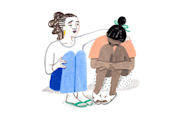I’ve experienced divorce in two different ways: Not only am I a child of divorce—my parents divorced when I was eight and my sister was four—I’m also the child of a divorce attorney. And the latter only made the former worse.
My mom and dad’s divorce had all the hallmarks of a salacious beach read—verbal and emotional abuse, cheating, lies, and of course the non-stop finger pointing. As if that wasn’t hard enough, my father, leveraging his role as one of the top divorce attorneys in our city, threatened that if my mom showed up with her own attorney, she’d never see her children again.
It’s no surprise, then, that my sister and I ended up staying with him. As soon as my mom moved out, he started dating my stepmom. Six months later, she and her two children moved into what was once my mom’s dream home.
Almost everyone has a story of divorce, whether it’s our parents’, the parents’ of childhood friends, family members, or even our own. Divorce is not a new concept.
But in all the turmoil, it can be forgotten that the biggest casualties in a divorce are often the children. Even when it’s amicable, divorce almost always results in significant changes, especially for kids: new house, new school, new people entering the familial circle.
Change is difficult in any situation, but for children it can feel overwhelming.
How can I help my kids through divorce?
Most parents want to do everything they can to minimize the impact of divorce on their children—even if it means working with their ex to develop a plan for co-parenting. On the other hand, there are some instances that are just too caustic, making working together impossible. In either case, there are steps parents can take to ensure their children feel supported as they try to navigate their “new normal.”
But in all the turmoil, it can be forgotten that the biggest casualties in a divorce are often the children.
Katie Malinski, LCSW-S, therapist, parenting coach, and founder of Telling the Kids, specializes in working with parents to help them create their parenting boundaries and supporting their children. In other words, she assists them in figuring out what works for them, what doesn’t, and how to best implement their desired approach within the confines of their particular situation. Here are her best tips:
1. Get your child a therapist (if you can)
The number one thing Katie recommends is getting children of divorce their own therapists. It gives them an unbiased outlet to express unfamiliar, and sometimes scary, emotions, and can teach healthy coping skills. A therapist can also provide children with a safe space to be themselves and talk about whatever is on their minds—without judgment.
Plus, the therapist can be a resource to children who need an advocate in tough situations. When I was 11, I was overcome with fear that I would never know what it was like to live with my mom. Because I had been so young when my parents divorced, and because my sister and I stayed with my dad, I had no memories of living with her.
It was a family psychologist who convinced my dad to give me an opportunity to try living with my mom. Without the psychologist’s intervention, I’m not sure it would’ve happened.
Being able to recognize and articulate emotions is not only good for the child’s own mental health, it can assist the parents in addressing any issues that may come up.

2. Give them an emotional vocabulary.
Sometimes, due to visitation rights and court rules, children are forced to spend time with parents who are not ideal and in situations that are not ideal.
As much as they can, it’s important for the other parent to give their child what Katie calls an “emotional vocabulary.” For younger children, this is incredibly helpful so that he or she can not only talk about what’s going on at the parent in question’s home, they’re also able to pinpoint whether they’re feeling sad or mad or frustrated.
For example: “when daddy yells at me to put my toys away I feel scared.” Being able to recognize and articulate emotions is not only good for the child’s own mental health, it can assist the parents in addressing any issues that may come up.
3. Teach them how to listen to their internal voice.
Along with the emotional vocabulary, another thing divorced parents can help their children with is finding their inner voice and learning how to listen to it. This is often communicated by asking questions about how things feel, and how they would’ve liked a particular situation to go—or even how they’d like to see things turn out in the future.
It takes time for them to understand that that voice in their head is really a good thing that can help them in uncomfortable situations, but with practice and ongoing discussions, kids can get there.
4. Equip the child to handle tough situations.
Parents can’t control what happens at each other’s houses, but they can try to equip their child to deal with it as best as possible. As Katie puts it, “I tell my clients if they can’t protect, then equip.” This involves discussing what goes on at the other parent’s house, how the child feels about it, and what they can do to remove themselves from situations that make them feel uncomfortable.
Examples include going to their bedroom for a break or maybe playing with kids in the neighborhood instead of staying in the house in what they feel like is a stressful situation. Keeping that dialogue open to help kids cope when things feel out of control—and giving them the agency to help themselves—is key.

You’re not alone
Since around the 1960s, the number of couples getting divorced has continued to gradually decline, according to CDC research, with one exception: There was an initial spike of 5.3 divorces per 1,000 Americans in the 1970s.
While no one can say with absolute certainty what directly caused this spike, it coincided with a time time when women were starting to aggressively enter the workforce and demand more independence. Another factor was likely the introduction and passing of “no-fault” divorce laws, which made it possible for couples to file for divorce without having to prove that one spouse had been unfaithful or abandoned the other.
“I tell my clients if they can’t protect, then equip.”
But since that spike, each decade has brought with it fewer and fewer couples seeking divorce. The CDC cites reasons like couples getting married later, with younger generations like millennials sometimes opting out of marriage altogether.
And for those who do pursue divorce, the rate of divorce mediation is on the rise. With more choices in how to handle separation, those willing to sit down and work with their soon-to-be former spouse look at mediation as an easier, more amicable, and more direct way of working out a settlement. In other words, no need to go to court.
But of course, unfortunately, not all divorces are amicable, and not all parents are willing to collaborate on a parenting plan that works for all involved.
This is what Katie Malinski calls a “high-conflict divorce.” In these situations, arming children with ways they can express their own desires and feelings about the unique situations divorce puts them in can be the key contributor to success. It’s the difference between divorce having a major negative impact on the child’s emotional and mental state long-term, and it being something the child was able to work through in a healthy way.
Using Katie’s four tips, parents can lay the foundation for healthy communication and honest expression of emotions early in the divorce process. But when asked, “if you had to choose just one, what would it be?” Katie was quick to say, “Therapy. Therapy is key to making it all work.”
NVSS - Marriages and Divorces. (2020). Retrieved November 23, 2020, from https://www.cdc.gov/nchs/nvss/marriage-divorce.htm
Thrive Global. (2019, July 30). The rising popularity of divorce mediation. Retrieved from https://thriveglobal.com/stories/the-rising-popularity-of-divorce-mediation/



